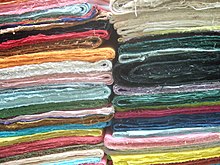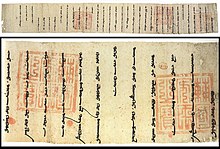
Papermaking is the manufacture of paper and cardboard, which are used widely for printing, writing, and packaging, among many other purposes. Today almost all paper is made using industrial machinery, while handmade paper survives as a specialized craft and a medium for artistic expression.

Pulp is a fibrous lignocellulosic material prepared by chemically, semi-chemically or mechanically producing cellulosic fibers from wood, fiber crops, waste paper, or rags. Mixed with water and other chemicals or plant-based additives, pulp is the major raw material used in papermaking and the industrial production of other paper products.
Rice paper is a product constructed of paper-like materials made from different plants. These include:

Fiber crops are field crops grown for their fibers, which are traditionally used to make paper, cloth, or rope.
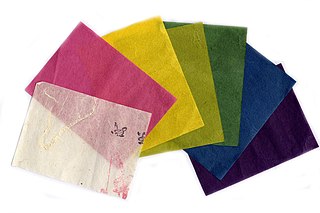
Washi (和紙) is traditional Japanese paper processed by hand using fibers from the inner bark of the gampi tree, the mitsumata shrub, or the paper mulberry (kōzo) bush.

The Korean tea ceremony is a traditional form of tea ceremony practiced in Korea. Darye literally refers to "etiquette for tea" or "tea rite" and has been kept among Korean people for over a thousand years. The chief element of the Korean tea ceremony is the ease and naturalness of enjoying tea within an easy formal setting.
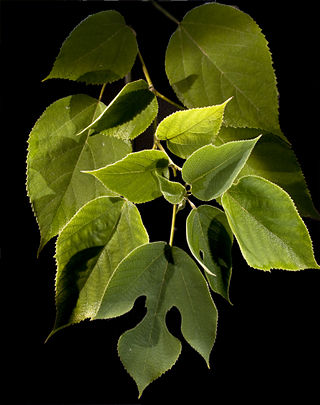
The paper mulberry is a species of flowering plant in the family Moraceae. It is native to Asia, where its range includes Taiwan, mainland China, Japan, Korea, Southeast Asia, Myanmar, and India. It is widely cultivated elsewhere and it grows as an introduced species in New Zealand, parts of Europe, the United States, and Africa. Other common names include tapa cloth tree.

A pulp mill is a manufacturing facility that converts wood chips or other plant fiber sources into a thick fiber board which can be shipped to a paper mill for further processing. Pulp can be manufactured using mechanical, semi-chemical, or fully chemical methods. The finished product may be either bleached or non-bleached, depending on the customer requirements.

Broussonetia is a genus of four species of trees in the family Moraceae, native to eastern Asia. These four species have high-quality fiber which consist of more than 90% of cellulose. They are traditionally applied for various daily necessities in South Eastern Asia and papermaking in East Asia.

Nonwoven fabric or non-woven fabric is a fabric-like material made from staple fibre (short) and long fibres, bonded together by chemical, mechanical, heat or solvent treatment. The term is used in the textile manufacturing industry to denote fabrics, such as felt, which are neither woven nor knitted. Some non-woven materials lack sufficient strength unless densified or reinforced by a backing. In recent years, non-wovens have become an alternative to polyurethane foam.

Abelmoschus manihot, commonly known as aibika, is a flowering plant in the family Malvaceae. It is a subshrub or shrub native to the Indian subcontinent, Indochina, central and southern China, Malesia, New Guinea, and Queensland. It was previously classified as a species of Hibiscus but is now categorized under the genus Abelmoschus. This plant is also referred to as the sunset muskmallow, sunset hibiscus, or hibiscus manihot.

Japanese tissue is a thin, strong paper made from vegetable fibers. Japanese tissue may be made from one of three plants, the kōzo plant, the mitsumata shrub and the gampi tree. The long, strong fibers of the kōzo plant produce very strong, dimensionally stable papers, and are the most commonly used fibers in the making of Japanese paper (washi). Tissue made from kōzo, or kōzogami (楮紙), comes in varying thicknesses and colors, and is an ideal paper to use in the mending of books. The majority of mending tissues are made from kōzo fibers, though mitsumata and gampi papers also are used. Japanese tissue is also an ideal material for kites and the covering of airplane models.
Printing and writing papers are paper grades used for newspapers, magazines, catalogs, books, notebooks, commercial printing, business forms, stationeries, copying and digital printing. About 1/3 of the total pulp and paper marked is printing and writing papers. The pulp or fibers used in printing and writing papers are extracted from wood using a chemical or mechanical process.

Dancheong refers to Korean version of Chinese traditional decorative colouring (Danqing)on wooden buildings and artifacts for the purpose of style. It literally means "cinnabar and blue-green" in Chinese and in Korean, and is sometimes translated as "red and blue" in English. Along with its decorations and the choice of paint colours, Dancheong carries various symbolic meanings. It is based on five basic colours; blue (east), white (west), red (south), black (north), and yellow (center). The use of those five colours reflected the use of the yin and yang principle and the Philosophy of the five elements.

Hwarot (Korean: 활옷) is a type of traditional Korean clothing worn during the Goryeo and Joseon eras only by royal women for ceremonial occasions and later by commoners for weddings. It is still worn during the pyebaek phase of modern weddings. Before commoners wore hwarots, they wore wonsam due to the steep cost of a hwarot. The gown is typically worn with a jokduri or hwagwan, binyeo or daenggi, and yeongigonji, which is red and black makeup spots on the cheek and brow.

Paper is a thin nonwoven material traditionally made from a combination of milled plant and textile fibres. The first paper-like plant-based writing sheet was papyrus in Egypt, but the first true papermaking process was documented in China during the Eastern Han period, traditionally attributed to the court official Cai Lun. This plant-puree conglomerate produced by pulp mills and paper mills was used for writing, drawing, and money. During the 8th century, Chinese paper making spread to the Islamic world, replacing papyrus. By the 11th century, papermaking was brought to Europe, where it replaced animal-skin-based parchment and wood panels. By the 13th century, papermaking was refined with paper mills using waterwheels in Spain. Later improvements to the papermaking process came in 19th century Europe with the invention of wood-based papers.

Dó paper is a paper made from the inner bark of the dó tree and traditionally produced in many villages in Vietnam. It plays an important role in folk art, Đông Hồ painting in particular, because of its durability.
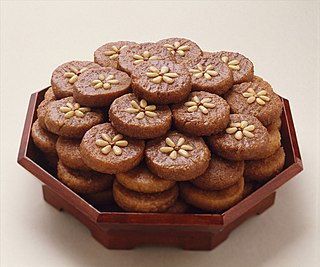
Yakgwa, also called gwajul (과줄), is a type of yumil-gwa, which is deep-fried, wheat-based hangwa made with honey, cheongju, sesame oil, and ginger juice. Traditionally, the sweet was offered in a jesa and enjoyed on festive days such as chuseok, marriages, or hwangap (sixtieth-birthday) celebrations. In modern South Korea, it is also served as a dessert and can be bought at traditional markets or supermarkets.
During ancient times, Korean craftsmen and women mastered a range of artistic techniques and utilized them to produce essential and decorative items in the traditional Korean home. These days, traditional handicrafts are still seen in Korean homes, but are also sold as souvenirs to foreign tourists that come to visit the country. Many of these handmade specialty crafts are found in Insadong or Bukcheon, where a lot of local craftsmen and women sell handicrafts. Not only do Korean handicrafts serve practical purposes, but are also a representation of the Korean culture itself. Many foreigners and locals appreciate traditional Korean handicrafts because of its colourful and intricate nature.
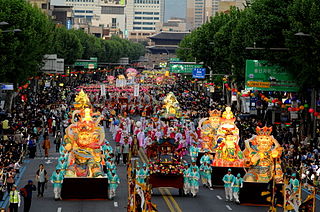
Yeondeunghoe is a lantern-lighting festival in Korea celebrating the Buddha's Birthday. The date of the celebration is marked on the Korean Lunar calendar as the eighth day of the fourth lunar month. The English translation of the name of the festival is written as Yeondeunghoe, Yeon Deung Hoe, or Yeondeung Hoe. Likewise, the exact English translation of the words, “Yeon” “Deung” “Hoe” are varied with suggested meanings as, “Lotus Lantern Festival” and “lighting a lantern.”
